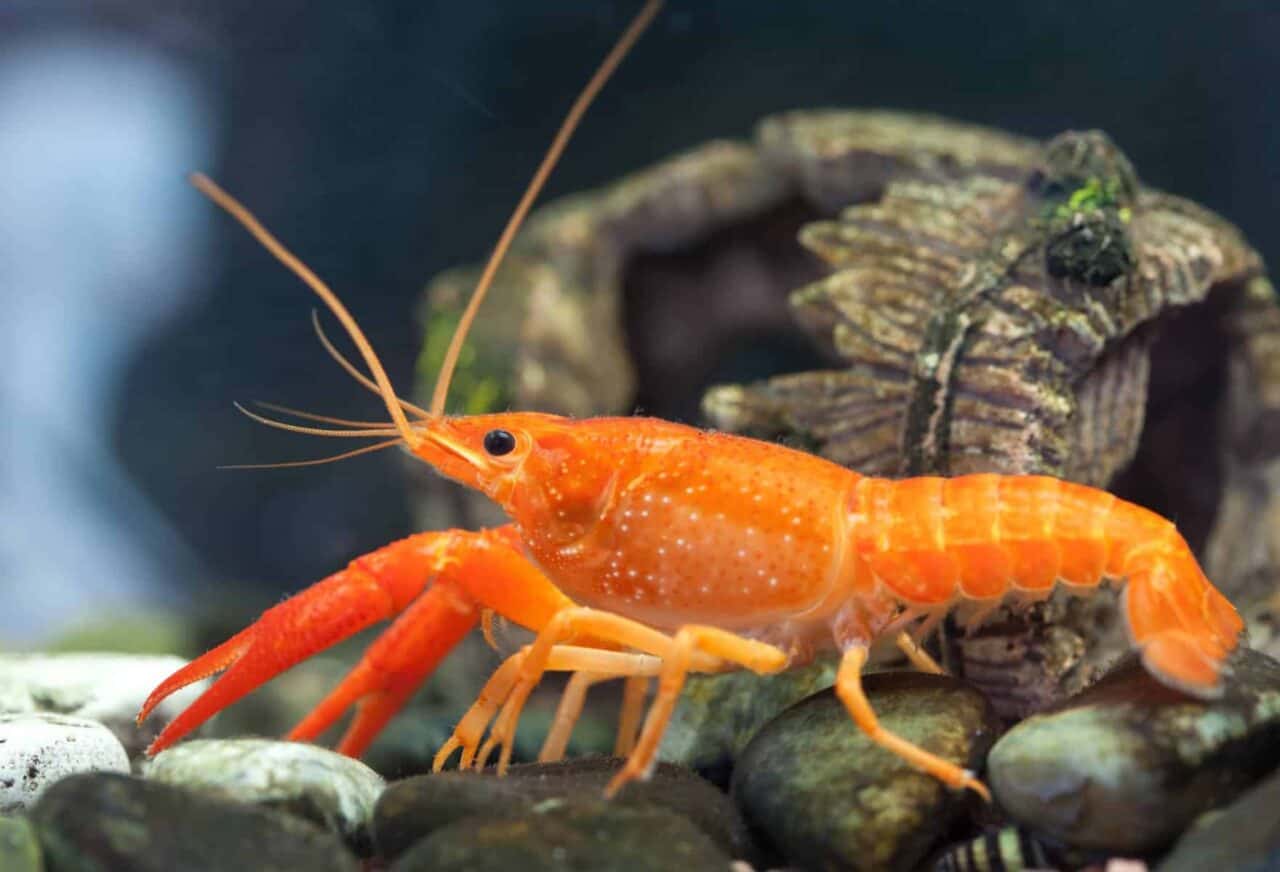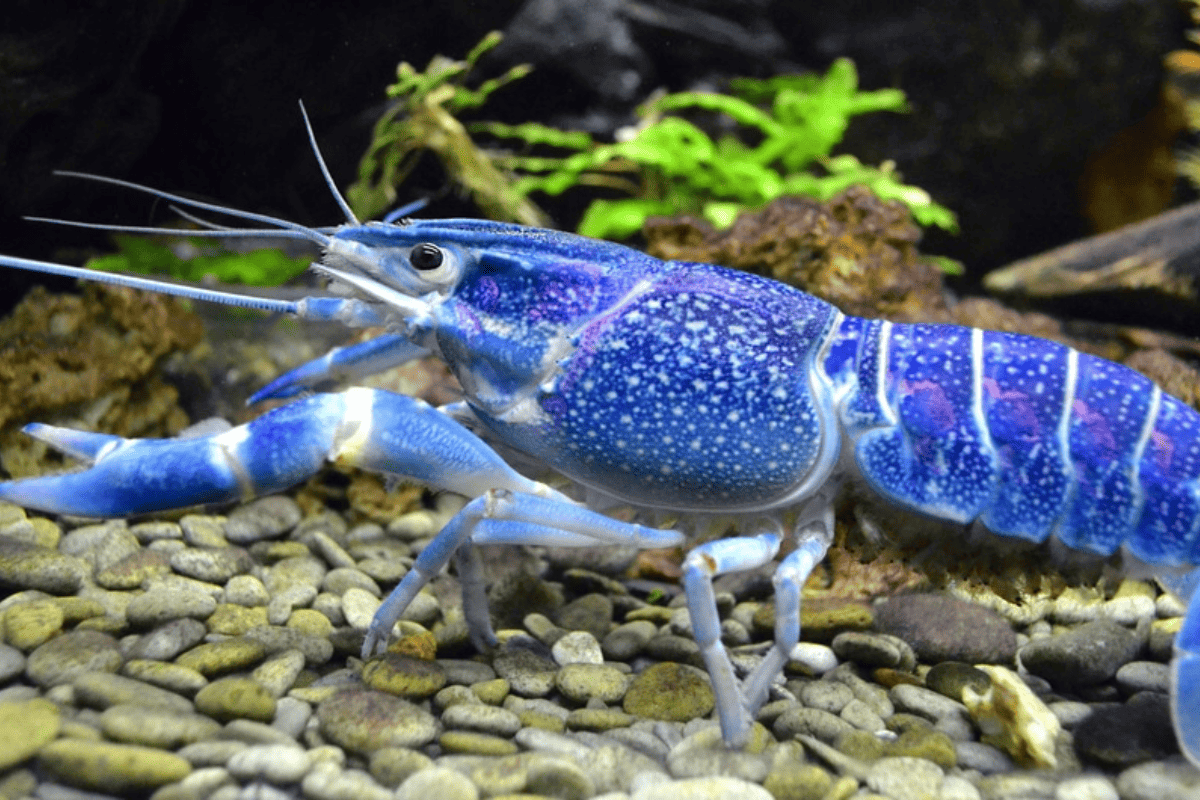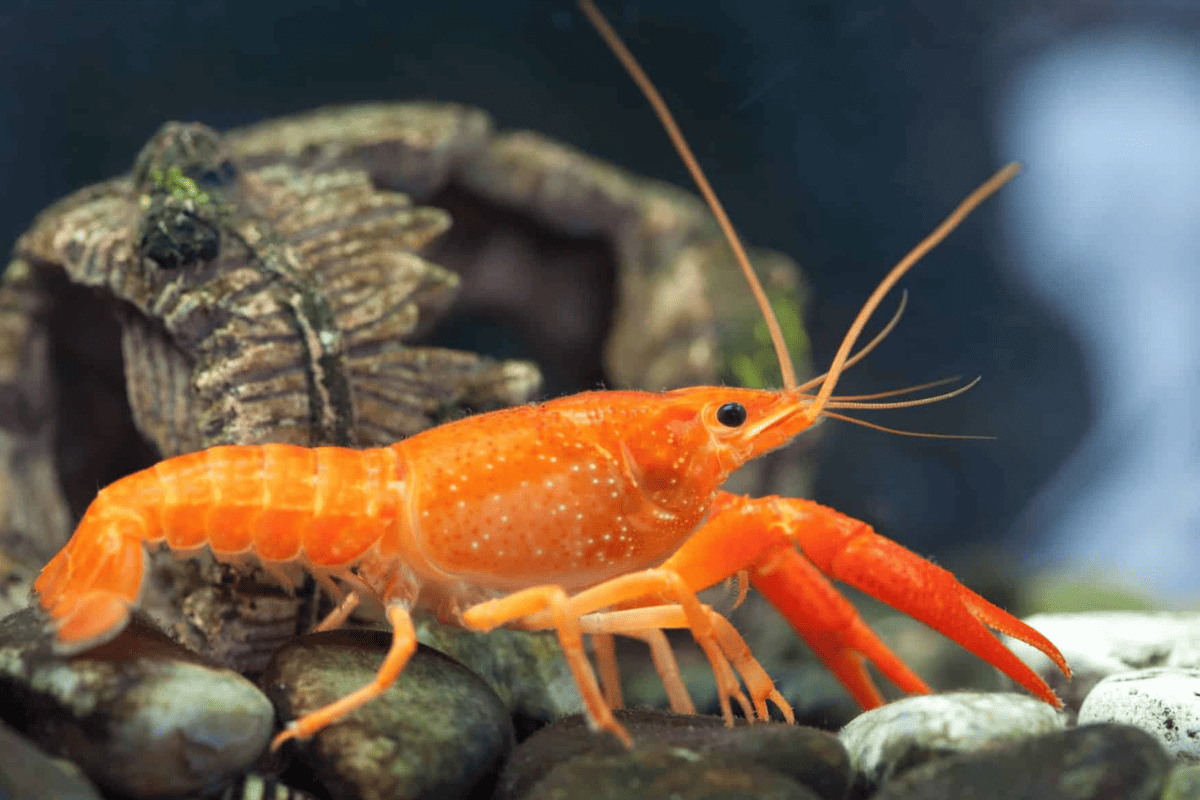Angelfish and Crayfish are popular choices for freshwater aquariums. However, is it feasible for them to coexist peacefully in the same tank?
What about the water requirements of each species? What should you expect when it comes to their behavior?
In this article, I’ll discuss all these questions and more, so you leave with all the information you need. Let’s get started.

Can I Keep Angelfish and Crayfish Together in the Same Tank?
No, keeping Angelfish and Crayfish together in the same tank is generally not advisable. Their coexistence poses significant risks to the well-being of the Angelfish.
- Predatory Behavior: Crayfish are opportunistic predators and may attack and harm Angelfish, especially at night when the fish are less active and more vulnerable.
- Territorial Nature: Crayfish are territorial and can become aggressive, stressing the Angelfish, who prefer a peaceful and stable environment to thrive.
- Different Habitat Needs: Angelfish require well-planted, warm-water environments, whereas crayfish need hiding places and cooler temperatures, making habitat compatibility challenging.
- Dietary Differences: The feeding requirements of Angelfish and crayfish differ significantly; crayfish might consume food intended for Angelfish or even attempt to feed on their fins.
Also Read: Angelfish Tank Mates
Angelfish vs. Crayfish: Behavior
The first factor worth considering is the Angelfish’s and Crayfish’s natural behavior. Here is what you should know:
1. Angelfish: Natural Behavior
Angelfish are known for their graceful swimming and peaceful demeanor in a community aquarium setting.
They exhibit complex social behaviors and prefer a structured hierarchy within their group.
- Social Hierarchy: Angelfish establish a clear pecking order within their groups, essential for maintaining harmony; mild chasing or nipping is common.
- Territorial during Breeding: Breeding Angelfish become territorial, often selecting a flat surface for egg-laying and fiercely guarding it against intruders.
- Preference for Calm Environments: Angelfish thrive in stable, calm environments, showing stress or discomfort in chaotic or overly active tanks.

2. Crayfish: Natural Behavior
Crayfish, in contrast, are bottom-dwellers known for their opportunistic and sometimes aggressive nature.
They are scavengers and can exhibit territorial behavior, especially in confined spaces like aquariums.
- Opportunistic Feeding: Crayfish are scavengers, often feeding on anything they can find, including plant material, detritus, and occasionally small fish or invertebrates.
- Territorial Tendencies: In aquarium settings, crayfish can become quite territorial, aggressively defending their chosen area from other tank inhabitants.
- Nocturnal Activity: Crayfish are primarily nocturnal, becoming more active at night, which can disrupt the daytime-dominant activity patterns of Angelfish.

Ideal Parameters for Angelfish and Crayfish
This table compares the ideal water parameters for Angelfish and Crayfish, highlighting the differences in their preferred environment.
It is important to understand these differences to maintain a healthy tank for each species.
| Parameter | Angelfish | Crayfish |
| Temperature | 76°F to 84°F (24°C to 29°C) | 65°F to 75°F (18°C to 24°C) |
| pH Level | 6.0 to 7.5 | 7.0 to 8.5 |
| Water Hardness | 3 to 8 dGH | 5 to 15 dGH |
1. Angelfish: Ideal Parameters
Angelfish thrive in a specific range of water parameters that mimic their natural Amazonian habitat. Maintaining these conditions is crucial for their health and well-being in an aquarium.
- Optimal Temperature: Angelfish prefer warmer water, ideally between 76°F to 84°F (24°C to 29°C). This temperature range supports their metabolism and immune system.
- pH Level: A slightly acidic to neutral pH, ranging from 6.0 to 7.5, is ideal for Angelfish. This mimics the natural water chemistry of their Amazon river habitat.
- Water Hardness: Soft to moderately hard water, with a general hardness (GH) of 3 to 8 dGH, is best suited for Angelfish. They are sensitive to extreme hardness levels.

2. Crayfish: Ideal Parameters
Crayfish are more adaptable than Angelfish but still require specific conditions for optimal health. Their natural habitat ranges from slow-moving rivers to freshwater lakes.
- Preferred Temperature Range: Crayfish are comfortable in cooler waters, with an ideal temperature range of 65°F to 75°F (18°C to 24°C). This range is lower than what Angelfish typically require.
- pH Level Suitability: A neutral to slightly alkaline pH, around 7.0 to 8.5, is optimal for crayfish. They are more tolerant of a wider pH range compared to Angelfish.
- Water Hardness Needs: Crayfish can tolerate a broader range of water hardness, generally between 5 to 15 dGH.

Angelfish vs. Crayfish: Tank Setup
This table outlines the differences in tank setup requirements for Angelfish and Crayfish. Each species needs specific conditions to thrive in an aquarium setting.
| Tank Setup Component | Angelfish | Crayfish |
| Ammonia, Nitrite, Nitrate | 0 ppm for ammonia and nitrite; below 20 ppm for nitrate | 0 ppm for ammonia and nitrite; tolerates slightly higher nitrate |
| Tank Size | Minimum 20 gallons for a pair, larger for groups | Minimum 20 gallons for one crayfish |
| Foliage | Dense, tall plants like Amazon Swords | Sturdy plants like Java Fern |
| Decorations | Smooth driftwood and rocks | Multiple hiding spots (caves, PVC pipes) |
| Filter | High-quality, larger tank filters | Strong filter, pre-filter sponge recommended |
| Heater | Essential, with stable temperature control | Not critical, but maintain 65°F to 75°F if used |
| Substrate | Soft, fine substrate like sand or fine gravel | Coarse sand or fine gravel for burrowing |
| Pump | Gentle water movement, avoid strong currents | Moderate water flow, avoid strong currents |
| Lighting | Moderate lighting for 8-10 hours a day | Standard aquarium lighting, avoid overly bright lights |
1. Angelfish: Tank Setup
Creating an ideal environment for Angelfish involves a careful balance of water conditions, tank size, and appropriate tank decor and equipment.
Their tank should replicate the natural conditions of the Amazon River as closely as possible.
- Ammonia, Nitrite, Nitrate: Keep ammonia and nitrite levels at 0 ppm, and nitrate below 20 ppm, using regular water testing kits to monitor.
- Tank Size: A 20-gallon tank is minimum for a pair, but 55 gallons or more is ideal for groups to prevent territorial stress.
- Foliage: Include tall plants like Amazon Swords or Anubias, which offer hiding spaces and mimic their native environment.
- Decorations: Use smooth-edged driftwood and rocks to create natural barriers and shelters without sharp edges that could harm the fish.
- Filter: Install a canister or hanging filter capable of cycling the entire tank’s water volume at least 3-4 times per hour.
- Heater: Use a submersible heater to maintain a stable temperature, ideally with a thermostat to avoid fluctuations.
- Substrate: Soft, fine-grained substrate, like sand or fine gravel, is ideal for supporting plant roots and mimicking natural habitats.
- Pump: An air pump should provide gentle circulation, avoiding strong currents as Angelfish prefer calmer waters.
- Lighting: Moderate lighting for 8-10 hours a day is ideal, simulating natural light cycles without causing excessive algae growth.
Also Read: Can Angelfish And Goldfish Live Together?

2. Crayfish: Tank Setup
Crayfish require a different set of parameters for their tank setup, focusing on their need for hiding places and a substrate suitable for burrowing.
- Ammonia, Nitrite, Nitrate: Like Angelfish, crayfish need ammonia and nitrite at 0 ppm; however, they can tolerate slightly higher nitrate levels.
- Tank Size: A minimum of 20 gallons is recommended for one crayfish, providing enough space for movement and territory establishment.
- Foliage: Opt for sturdy plants like Java Fern, as crayfish may uproot delicate plants or use them as food.
- Decorations: Include multiple hiding spots using caves or PVC pipes, as crayfish are nocturnal and like secluded spaces.
- Filter: A strong filter is necessary, as crayfish produce more waste; a filter with a pre-filter sponge is ideal to protect smaller crayfish.
- Heater: A heater is not as critical for crayfish, but if used, should maintain a temperature between 65°F and 75°F.
- Substrate: Choose a substrate that allows for burrowing, like coarse sand or fine gravel, which also supports beneficial bacteria growth.
- Pump: A pump that provides moderate water flow is ideal, as crayfish enjoy some water movement but not strong currents.
- Lighting: Standard aquarium lighting is sufficient; crayfish are not as sensitive to light as Angelfish, but avoid overly bright lights.

The Dietary Requirements of Angelfish and Crayfish
This table compares the dietary requirements of Angelfish and Crayfish, illustrating the differences in their feeding habits and needs.
| Dietary Aspect | Angelfish | Crayfish |
| Food Types | High-quality flakes/pellets, live/frozen foods like brine shrimp, bloodworms | Sinking pellets or algae wafers, vegetables, occasional protein |
| Quantity | Small amounts, 2-3 times a day, under five minutes of feeding | Enough food to finish within a couple of hours, once a day |
| Feeding Schedule | Consistent daily feeding, varied diet | Once daily, preferably in the evening |
1. Angelfish: Ideal Dietary Requirements
Angelfish have specific dietary needs that are crucial for their health and coloration.
They are omnivores in nature, requiring a balanced diet of proteins, vegetables, and occasional live food.
- Food Types: Angelfish thrive on a diet of high-quality flakes or pellets, supplemented with live or frozen foods like brine shrimp or bloodworms for protein.
- Quantity: Feed Angelfish small amounts that they can consume in under five minutes, typically two to three times a day, to prevent overfeeding and tank pollution.
- Feeding Schedule: Consistency is key; feed Angelfish at the same times each day, with a varied diet to ensure all nutritional needs are met.

2. Crayfish: Ideal Dietary Requirements
Crayfish are opportunistic feeders, less finicky than Angelfish, and require a diet that supports their constant growth and shell regeneration.
- Food Types: A diet for crayfish should include sinking pellets or algae wafers, supplemented with vegetables like zucchini or peas and occasional protein sources.
- Quantity: Crayfish should be fed enough food that they can finish within a couple of hours, once a day, to avoid overfeeding and water quality issues.
- Feeding Schedule: Feeding crayfish once daily in the evening aligns with their nocturnal nature, ensuring they get enough nutrients without competing with daytime feeders.

More Suitable Tank Mates for Angelfish
Finding the right tank mates for Angelfish is essential for a harmonious aquarium. They do best with similarly sized, peaceful fish that do not have long fins or aggressive tendencies.
- Corydoras Catfish: These bottom dwellers are peaceful and won’t compete with Angelfish for space. They help keep the tank clean by scavenging for food.
- Dwarf Gourami: A calm and colorful addition, Dwarf Gouramis coexist well with Angelfish without causing stress or competition for territory.
- Mollies: Mollies are adaptable and peaceful, making them excellent companions for Angelfish. They add activity and color to the tank without aggression.
- Platies: Platies are hardy and peaceful, ideal for a community tank with Angelfish. They are active swimmers but don’t bother other fish.
- Rummy-nose Tetra: These schooling fish are known for their peaceful nature and striking appearance, making them a safe choice with Angelfish.
- Zebra Danios: Fast swimmers and hardy, Zebra Danios are good tank mates for Angelfish as they usually stay out of their way.
- Loaches: Many loach species are peaceful and occupy the bottom regions of the tank, avoiding conflicts with Angelfish.
Also Read: Can Angelfish Live With Shrimp?

Possible Tank Mates for Crayfish
Crayfish can be challenging to pair with other fish due to their opportunistic nature, but certain species can coexist with them in a well-structured aquarium.
- Barbs: Tiger Barbs or Cherry Barbs can be suitable as they are fast swimmers and generally stay away from the bottom where crayfish reside.
- Guppies: Although small, Guppies are quick and agile, often avoiding the slower-moving crayfish. They add color and activity to the tank.
- Danios: Danios, like the Zebra Danio, are fast and occupy the upper levels of the tank, keeping them out of reach from crayfish.
- Tetras: Larger tetras, such as Black Skirt Tetras, can coexist with crayfish as they are fast and tend to swim in higher water columns.
- Swordtails: Swordtails are another option; they are agile and usually stay near the top of the aquarium, away from the crayfish’s territory.

How to Introduce Crayfish to a Fish Tank
Introducing crayfish to a fish tank requires careful planning and observation to ensure a smooth transition and minimize stress for both the crayfish and the fish.
It’s important to introduce them in a way that respects the territorial nature of the crayfish and the safety of the fish.
- Quarantine Period: Always quarantine the crayfish in a separate tank for at least two weeks to ensure they are healthy and free from diseases that could spread to the fish.
- Tank Compatibility: Check that the tank size and setup are suitable for both crayfish and fish, ensuring enough space and hiding spots for the crayfish to feel secure.
- Gradual Introduction: Introduce the crayfish to the main tank during a time when the fish are most calm, preferably in the evening when the fish are less active.
- Monitor Behavior: Observe the behavior of both the crayfish and the fish closely in the initial days, ready to intervene if there are signs of aggression or stress.
- Feeding Strategy: Feed the fish and crayfish at different ends of the tank to reduce competition for food and minimize potential conflicts during feeding times.
Conclusions
For quick readers, here’s a short summary:
- Angelfish and Crayfish have incompatible needs and behaviors, making their cohabitation in the same tank generally inadvisable due to risks to Angelfish.
- Crayfish are opportunistic predators and territorial, which can lead to stress and harm to the more peaceful Angelfish, especially during night when they are vulnerable.
- Angelfish and Crayfish require different water conditions and tank setups, with Angelfish preferring warmer, well-planted environments and Crayfish needing cooler temperatures and hiding spots.
- Their dietary needs differ significantly, with Crayfish potentially consuming food meant for Angelfish or even attacking them.
- While Angelfish pair well with other peaceful fish, Crayfish are better suited with faster, more agile fish to minimize conflicts in shared tanks.
